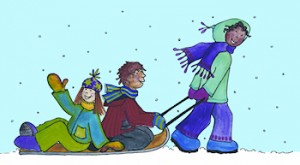it’s cool (but not cold) to winter walk and bike
the following is a freelance article that will be popping up in print soon. i’ll post the link when it is published. in the meantime:
The winter winds are howling, there is snow in the forecast, and the temperature is well into the wrong side of zero. And while it hardly seems suitable weather for walking to school, the kids are eager to get bundled up and go.
Well, as eager as a kid can be when school is involved.
Winter cold, it seems, is a matter of perspective.
Or perhaps a matter of apparel.
Just because the weather has turned wintery, there is no reason to ditch active and efficient methods of getting to school. And while it may take a bit of forethought, walking and even biking can and should remain an essential part of your child’s daily activity.
Why consider winter walking and biking?
There are a few reasons. First of all, children today are not receiving enough exercise. According to The Public Health Agency of Canada, over half of today’s kids are not active enough for healthy growth and development. This is especially true during winter, when supervised outdoor play time disappears as parents chose more indoor activities. Walking and biking to school can help kids get the exercise they need.
Then there is the environment and its effect on health. You don’t have to look very far to find news of climate change and poor air quality issues. The correlation between vehicle use and these issues are well documented.
If these larger-scale issues are not alarming enough, poor air quality in school zones is an issue that should hit even closer to home.
Natural Resources Canada has reported that increased traffic and vehicle idling around schools has been shown to negatively affect school zone air quality. This is especially alarming when you consider that children breathe more deeply and faster than adults, have lungs that are still developing, and inhale more pollution per kilogram of body weight than adults.
The best solution for this is to reduce the number of vehicles in school areas. Including yours. Easier said than done during the colder months of winter? It doesn’t have to be.
As I have said, kids don’t seem to mind winter nearly as much as adults do. And with the right clothing, shouldn’t be affected by the weather at all. There are exceptions to this rule. On extreme cold weather days, when the cold can become hazardous, or on heavy snow days, when visibility and traction become issues, it may be best to carpool or take public transit.
Some tips for winter dressing:
Hands:
Mittens are better than gloves at keeping hands warm. The larger pocket of air offers increased insulation and makes better use of body heat than the segregated fingers of gloves. A wind and water resistant outer shell is recommended. Packing a spare pair in your child’s knapsack is never a bad idea.
Footwear:
Insulated waterproof boots are a must for winter walking. Again, a spare pair of socks in the knapsack can help keep feet dry and warm. For icy conditions, you may want to try child-sized Yaktrax, a slip-on rubber and metal coil contraption that offers sure-footed traction.
Outerwear:
Coats should be both insulated and water/windproof. Layers are a good idea, as kids can adjust to the changing temperatures – especially important during early and late winter. Scarves and hats are a must for cold weather. Coats and knapsacks should also have some form of reflective material on them, as it is harder for drivers to see children during the shorter, darker days of winter.
Remember that woolen and fleece clothing helps retain heat. Long underwear can be worn on particularly cold days, and a change of clothes can always be sent along on wet or snowy days.
Kids who walk without adult supervision should be encouraged to travel in pairs or groups. They should always walk on sidewalks. Special care should be taken when crossing at intersections, as cars may not be able to stop as efficiently.
While extra care should be taken with winter biking, it does not necessarily need to be dropped for the season. With winters getting warmer, streets are often perfectly clear of snow for much of the season, making for great conditions for older kids and youth to bike. I would not recommend youth biking during snowy or icy conditions, but on warmer, snow-free days, it remains a fun and viable option.
As with walking, care needs to be taken when dressing. The addition of shell pants is particularly useful.
Wide tires with widely separated knobs work best on snow, though more and more people are switching to steel or carbide tipped studs. Be sure to have your bike tuned before you start winter riding.
Of course, the first step to winter walking and biking is to get in the right mindset. Kids don’t seem to mind the snow and cold – heck, they usually can’t wait to get out into it and play. Now if we can only get mom and dad to feel the same way…
One thought on “it’s cool (but not cold) to winter walk and bike”
Comments are closed.


great article and very appropriate for today–here in Cambridge MA it was about 5 degrees Fahrenheit this morning.
I work with a Cambridge based non-profit–see the link. We have been promoting the last Friday of every month as a walk/ride day with some fun monthly activities and promotions to keep people motivated. Here in Cambridge plenty of folks walk, bike or take the bus everyday but the cold whether unfortunately sends too many back to their cars.
I am going to add a link at our web site.
Sarah
Cambridge Coordinator Walk/Ride Days Program